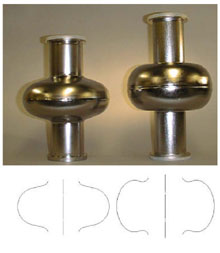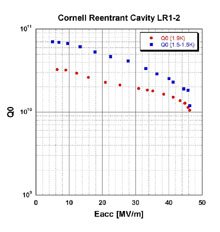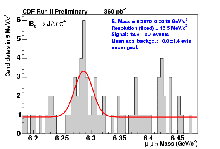 | Friday, December 3, 2004 |
|
Friday, December 3 3:30 p.m. DIRECTOR'S COFFEE BREAK - 2nd Flr X-Over 4:00 p.m. Joint Experimental Theoretical Physics Seminar - 1 West Speaker: S. D'Auria, University of Glasgow Title: Bc: Fully Reconstructed Decays and Mass Measurement at CDF 8:00 p.m. Fermilab Film Series - Auditorium Tickets: Adults $4 Title: Sunset Boulevard
Saturday, December 4
Monday, December 4 |
|
Friday, December 3 New England Clam Chowder Western BBQ Burger $4.75 Turkey Tetrazzini $3.75 Meatballs Teriyaki Over Rice $3.75 Bistro Chicken & Provolone Panini $4.75 Assorted Personal Size Pizzas $3.25 Carved Top Round of Beef $4.75 |
|
Extended Forecast |
Secon Level 3 |
| Fermilab Today is online at: http://www.fnal.gov/today/ Send comments and suggestions to today@fnal.gov Fermilab Today archive Fermilab Today PDF Version Fermilab Result of the Week archive Fermilab Safety Tip of the Week archive Linear Collider News archive Fermilab Today classifieds Subscribe/Unsubscribe to |
|
What's Up with the ILC? The entire International Linear Collider series is available online. Going for Higher Gradients as Cornell Makes a Breakthrough | ||
| ||
|
At the Cornell University Laboratory of Elementary Particle Physics
(LEPP), Valery Shemelin, Rongli Geng and Hasan Padamsee have reached a
world record accelerating field gradient of 46 MV/m in a single
superconducting accelerator cavity, expanding the possibilities for the
proposed International Linear Collider.
"If we can achieve this gradient in a nine-cell structure with this technique, it would give us more 'overhead' in our design," said Shekhar Mishra, Head of ILC Efforts at Fermilab. "Possible options resulting from this 'overhead' would be that we could make the machine shorter in length at the same energy or higher energy reach at reduced luminosity, keeping the same beam power." The current best gradient for nine-cell accelerating structures is 35-40MV/m achieved by the TESLA Collaboration at DESY. New ideas are usually proved in single cell cavities before addressing the technical challenges of multi-cell accelerating units, and an important R&D goal is to push gradients even higher for TeV energies or cost savings. But above 40 MV/m, the surface magnetic field approaches the limit where superconductivity breaks down. Shemelin, Geng and Padamsee altered the shape of the cavity, lowering the surface magnetic field by 10% and preserving superconductivity. The new cavity shape has the same beam aperture as the TESLA cavity, meaning the beam dynamics are likely to be similar to those of TESLA. cavity. Similar projects on the way at Jlab-DESY-KEK have achieved a gradient of about 40 MV/m. But the beam aperture of the new shapes is smaller than that of the TESLA cavity, and hence the effects on the beam need to be evaluated. The working group on the High-Gradient Cavities at the KEK ILC workshop has endorsed the High Gradient R&D efforts. | ||
|
|
From the Nature Magazine, December 2, 2004 Putting pen to paper by Virginia Gewin Careers in journalism can be rewarding for scientists who have a way with words. Virginia Gewin reveals what it takes to be a scribe. If you love science but hate lab work, trading the monotony of running gels for the creative buzz of writing may sound appealing. But before you abandon the bench and grab your laptop, make sure you understand the odds and options ahead. A staff position as a science journalist is as rare as it is coveted. In fact, many more opportunities exist for public information officers or freelance writers. Whatever the position, the ability to communicate is the common denominator. Read more |
|
Fermilab Today is featuring a special Result of the Week timed to coincide with today's Wine & Cheese seminar by CDF.
CDF Sees Charmed Beauty Meson in a New Decay Mode |
|
The Bc meson, one of the heaviest meson states predicted by
the Standard Model, consists of a bottom and a charm
quark-antiquark pair. Using semileptonic decays in Run I,
CDF published the first experimental observation of the Bc
which was recently confirmed by DZero using Run II data.
In both cases the mass was only approximately determined because
the state was incompletely reconstructed.
The CDF collaboration has now announced the preliminary results of a further search for the Bc, this time using decays into a J/psi and a charged pion, so that all the final-state particles could be precisely measured. In seeking to detect a rare state of this kind, it is important not to bias the results by making experimental selections that might merely enhance a random fluctuation in the mass distribution. Therefore, a 'blind' analysis was performed; the analysis method was implemented using simulations of a possible signal, and only when the method was fully optimized on this basis was the experimental mass distribution examined. The result shows a narrow mass peak with a probability of less than 0.1% of being due to a chance fluctuation. The position of the peak is at 6287+/-5 MeV. We are in the process of characterizing the signal and performing further checks. Several theoretical approaches have been used to predict the Bc mass: potential models, potential NRQCD and Lattice QCD. Their predictions are in good agreement with this preliminary measurement. Please attend today's 4:00 p.m. Wine and Cheese seminar for more details. |
|
Result of the Week Archive
|
|
New Classifieds on Fermilab Today New classified ads have been posted on Fermilab Today. A permanent link to the classifieds is located in the bottom left corner of Fermilab Today.
Fermilab Film Series Tonight
Fermilab Arts Series This Weekend
Hatha Yoga Class
|



